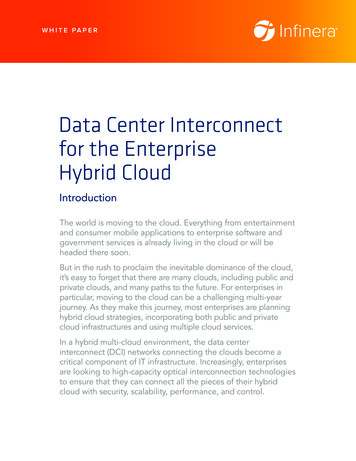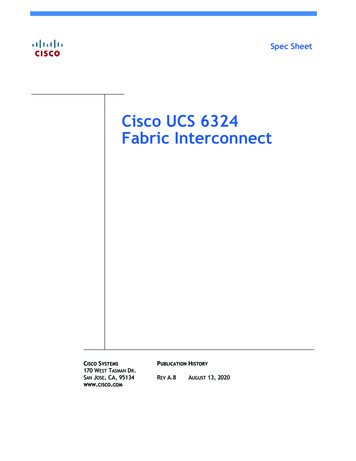
Transcription
W H I T E PA P E RData Center Interconnectfor the EnterpriseHybrid CloudIntroductionThe world is moving to the cloud. Everything from entertainmentand consumer mobile applications to enterprise software andgovernment services is already living in the cloud or will beheaded there soon.But in the rush to proclaim the inevitable dominance of the cloud,it’s easy to forget that there are many clouds, including public andprivate clouds, and many paths to the future. For enterprises inparticular, moving to the cloud can be a challenging multi-yearjourney. As they make this journey, most enterprises are planninghybrid cloud strategies, incorporating both public and privatecloud infrastructures and using multiple cloud services.In a hybrid multi-cloud environment, the data centerinterconnect (DCI) networks connecting the clouds become acritical component of IT infrastructure. Increasingly, enterprisesare looking to high-capacity optical interconnection technologiesto ensure that they can connect all the pieces of their hybridcloud with security, scalability, performance, and control.
Enterprise Hybrid Cloud MomentumA large majority of enterprises already use or plan to use a hybrid cloud infrastructure. Forexample, in one survey,1 67 percent of enterprise survey respondents are hybrid cloud users,employing both private clouds and public cloud services, meaning infrastructure as a service(IaaS) and platform as a service (PaaS) offerings such as those from Amazon Web Services (AWS),Microsoft Azure, and Google Cloud Platform (GCP).The same survey notes increasing interest in using multiple public clouds. The implication of thisis clear: few enterprises are ready to move all their applications to a single public cloud.The reasons for choosing a hybrid cloud strategy are numerous, including: Enterprises want to maintain tight control over mission-critical data Enterprises want to evaluate cloud services methodically, validating performance, security, andoperational processes on some applications before moving to others With dozens of applications to consider and limited IT staff, migration to the cloud takes time Some legacy applications are hard to “cloudify” (i.e., to modify to run in the cloud)But even though enterprises may hesitate to put everything into a public cloud environment, theyare also reluctant to invest further in data centers that they build and run themselves. That leadsto a growing market for colocation and managed or hosted cloud infrastructure services thatprovide many of the benefits of a private cloud with more flexibility and reduced investment risk.Figure 1 highlights the reasons for using varying infrastructures in a hybrid cloud strategy.appmobilityPublic Cloud Lowest cost Easiest scaling Multi-cloudflexibilityEnterpriseData Center Maximum control ofcritical apps, data Maintain legacy apps Phase migration tocloudappmobilityPrivate Cloud Offload management Improve scalability Maintain necessarysecurity, controlFigure 1: Advantages of different infrastructures in a hybrid cloudPage 2
PrivateCloud DCEnterpriseData CenterInternetExchangeEnterpriseColocationPublic CloudsFigure 2: Data center types that play a role in hybrid cloudsAs a result, for many enterprises, the hybrid cloud runs in multiple different types of data centers,as depicted in Figure 2: Enterprise-owned and -managed data centers Enterprise-managed infrastructure in colocation facilities Hosted or managed private cloud service provider data centers, referred to as “private cloud”data centers Public cloud service provider data centers, often reached via direct connections at an internetexchange (IX) data center or a similar carrier-neutral facilityConnecting a hybrid cloud means connecting many or all these types of data centers. Let’sexamine the requirements for such data center interconnection.DCI Requirements for the Hybrid CloudData center interconnect for a hybrid cloud can have very different requirements than traditionaldata center interconnect, or even than some early approaches to public cloud connectivity.Historically, DCI requirements have varied widely depending on the application. The mostdemanding DCI scenarios typically involved high-capacity and low-latency synchronous datamirroring, in which storage area networks (SANs) were directly connected across fiber opticnetworks to enable all data to be replicated in two locations to guarantee zero data loss inthe event of a failure in one location. Such DCI links must be no longer than around 50 to 100kilometers (km) to limit the delay experienced by applications waiting for a remote disk writeoperation to be completed. And since fiber optic networks were historically complex and costly,only the most sophisticated enterprises in financial services and a few other industries could affordto build and operate them. A much larger proportion of historical DCI links were set up with lowercapacity and less stringent latency requirements to support asynchronous backup and replication,and occasional data or application migration, with more manageable costs.Looking at connectivity to public cloud services, many enterprises started off experimentingwith connecting via virtual private network (VPN) over the internet. This was sufficient forsmall applications with limited need to exchange data outside of the cloud environment,such as software development, compute-intensive simulations, or batch processing jobs. Asother applications requiring more reliable connectivity and performance moved to the cloud,enterprises have tended to move cloud connectivity to managed connectivity services such asMultiprotocol Label Switching (MPLS) VPNs. But as hybrid cloud DCI bandwidth requirementscontinue to grow, these services can become very expensive and may not provide the consistentlyhigh performance needed.Page 3
Looking forward, hybrid clouds will need far more from their networks than some of these pastDCI applications. Several trends are driving new DCI network demands: Distributed application architectures: In a hybrid cloud environment, applications may becomposed of multiple components, with a front-end web server in a public cloud, specializedapplication components running in a hosted private cloud environment, and a back-enddatabase with highly sensitive data running in a tightly controlled enterprise data center.Communication between these components can require several times more bandwidth than theuser-to-application traffic, and the application’s performance can be highly sensitive to networklatency or packet loss in between components. Dynamic application mobility and scalability: A hybrid cloud offers the potential to usemultiple cloud infrastructures for the same application, whether to scale out compute capacitybeyond the limits of a single data center, move application workloads based on cost orperformance, or simply migrate applications to a different environment over time withoutincurring any application downtime. Application mobility can be particularly valuable inproviding mobile end users the best experience as they travel by moving their applications anddata, such as an email inbox, to a cloud data center near their current location. Cloud-based data replication: Hybrid clouds based in multiple physical locations offernew business continuity opportunities. For many hybrid cloud users, the first step in takingadvantage of these opportunities is to use cloud-based data backup and replication tocomplement other data protection schemes. Continuous application availability: More sophisticated enterprise users are moving towarda completely new model for continuous global application availability that is not based on bulkdata replication and recovery plans, but rather on distributed systems architectures (Figure 3).By running applications in multiple locations and continuously synchronizing critical data acrosslocations, an enterprise can ensure that the applications are protected against the loss of anyserver or application instance, any copy of application data, or even the loss of an entire location.These architectural shifts dictate two key requirements for hybrid cloud DCI: predictable lowlatency and loss, and high base capacity with easy scalability.BackupActive-StandbyActive-ActiveCloud VMmobilityGlobalapplicationavailabilityData duplicationData center duplicationLeverage flexibleinfrastructureArchitect for inherentsurvivabilityEnablersVirtualization, shift to cloud architecturesWidely available, highly connected colocationDeclining cost of massively scalable bandwidthFigure 3: Evolving business continuity and application availability strategiesPage 4
Another critical requirement for hybrid cloud DCI is security. Overall, security is one of the topconcerns for enterprises moving applications to the cloud, and security of DCI links must beconsidered within that broader concern. To ensure DCI security, in-flight data encryption is anemerging requirement for many enterprises.One final requirement for hybrid cloud DCI is operational efficiency, which translates into lowoperational expenses due to monthly recurring telecom service charges, equipment space andpower requirements, and operations staff costs.Below is a summary of DCI requirements for hybrid clouds:1. Predictable low latency and packet loss2. High base capacity with easy scalability3. In-flight encryption of all data4. Low recurring service costs5. Space and power efficiency6. Simple operationsHybrid Cloud DCI SolutionsLooking at the DCI requirements outlined above, it’s clear that internet-based VPNs won’t meetcapacity and performance needs. MPLS VPNs and other shared packet network services may besufficient for some enterprise customers, but as capacity and performance demands grow, thoseservices may fall short in terms of insufficient performance service level agreements (SLAs), highrecurring service costs, lack of security, or all these factors.In those cases, the best alternative may be dedicated fiber-based networks with wavelengthdivision multiplexing (WDM) systems, which can deliver the highest capacity, scalability,performance, and security while giving the enterprise more control as its needs change.But what about cost and operational complexity? It’s true that dedicated optical networks weretraditionally too costly and complex for most customers, but those barriers are substantially lowertoday. In many metro areas, dark fiber is readily available and relatively inexpensive, and newerhigh-capacity WDM systems are increasingly compact, power-efficient, cost-effective, and muchsimpler to install and use than older optical network equipment .Point-to-point and Point-to-multipoint Compact DCI PlatformsTo achieve maximum DCI bandwidth with minimum cost, space, power, and complexity, Infineraintroduced the first compact DCI platform in late 2014, and adoption has been growing rapidlyever since. Additional platforms have since been added to the portfolio, which now includes theCloud Xpress (CX) Series, the Groove (GX) Series G30, and the most recent addition, the GXG40, to further reduce the cost of transport and significantly increase capacity while enablingnetwork automation. These platforms support various mixes of client interfaces like 10 gigabitsper second (Gb/s), 40 Gb/s, 100 Gb/s, and 400 Gigabit Ethernet, as well as multi-service supportincluding OTN, Fibre Channel, SONET/SDH, and many others over flexible line interfaces from100 Gb/s to multiple terabits per second (Tb/s). Figure 4 depicts Infinera’s compact modularportfolio.Page 5
XT-3300CX-1200GX G30, G40, G60Figure 4: Infinera compact modular DCI platformsInfinera’s compact modular DCI platforms offer true plug-and-play operations, with an all-in-onesystem design requiring no external components; a simple 1-2-3 configuration process; supportfor automation, including zero-touch provisioning; and the ability to scale capacity with theclick of a mouse, adding 100 Gb/s of capacity at a time. Enterprises with no prior experienceoperating WDM-based optical networks have been successful deploying such systems withoutthe need to go through extensive training.Flexible Chassis-based WDM PlatformsIn some cases, the simplicity of a compact DCI platform is not the best fit for an enterprise’sneeds, so a more flexible chassis-based WDM platform can be used. Benefits of such platformsinclude: Flexible topologies, including point-to-point, multipoint, and mixes of the two Flexible traffic routing and grooming with switching at the optical layer (reconfigurable opticaladd-drop multiplexer or ROADM), Optical Transport Network (OTN) layer, or Layer 2 (Ethernetswitching) Cost-efficient support for lower aggregated capacities under 100 Gb/sEven when such a flexible WDM system is needed, resulting in more configuration stepscompared to compact DCI platforms, the overall level of system simplicity and manageabilitycan still be a good fit for many enterprise DCI requirements, as numerous deployments havedemonstrated.Page 6
Building Hybrid Cloud Networks with Optical DCISome hybrid clouds may only need the scalability, performance, and security benefits ofdedicated optical DCI on selected links, but as hybrid cloud demands grow, many enterpriseswill benefit from a completely optical DCI network, built with either compact modular DCIappliances, flexible WDM platforms, or a mix of the two, as shown in Figure 5.InternetExchangePublic CloudsPrivateCloud DCDedicated opticaldata center interconnectEnterpriseData CenterGeographicallydistributed locationsEnterpriseColocationFigure 5: Hybrid cloud architecture using dedicated optical DCISummaryMany enterprises implementing hybrid cloud strategies will need to enhance their DCI networksto support their application performance, security, and availability needs. While in the past,traditional dedicated optical networks were too costly and complex for all but a few enterprises,increased dark fiber availability and the emergence of simple, efficient optical DCI platforms nowmake it feasible for a much wider range of enterprises to implement dedicated optical DCI withthe security, scalable capacity, high performance, and control needed to optimize their hybridclouds and satisfy their end users.1 RightScale 2017 State of the Cloud Report (https://www.rightscale.com/lp/state-of-the-cloud) 2020 Infinera Corporation. All Rights Reserved. Infinera and logos that contain Infinera are trademarks or registered trademarksof Infinera Corporation in the United States and other countries. All other trademarks are the property of their respective owners.Statements herein may contain projections regarding future products, features, or technology and resulting commercial or technicalbenefits, which are subject to risk and may or may not occur. This publication is subject to change without notice and does notconstitute legal obligation to deliver any material, code, or functionality and is not intended to modify or supplement any productspecifications or warranties. 0186-WP-RevB-0620
Page 2 Enterprise Hybrid Cloud Momentum A large majority of enterprises already use or plan to use a hybrid cloud infrastructure. For example, in one survey,1 67 percent of enterprise survey respondents are hybrid cloud users, employing both private clouds and public cloud services, meaning infrastructure as a service











